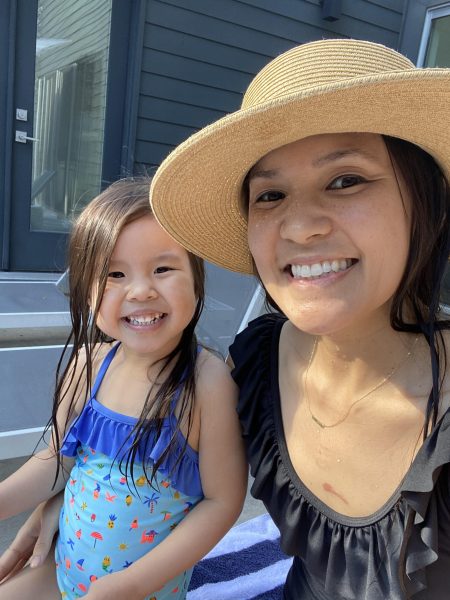We chat with working parent advocate Sherrie Nguyen, Senior Manager, Product Marketing at Indeed
Sherrie Nguyen advocates not just for working parents within and outside her company Indeed, but for a work-life integration for everyone. But new moms and dads have more on their plates than most of us, so that work-life balance can come crashing down that much harder for them when the plates stop spinning.
The things that led Sherrie to start an Inclusion Resource Group (IRG), sometimes called an Employee Resource Group (ERG), at Indeed are probably the same issues that face a lot of parents in the workplace. The Parents and Caregivers Inclusion Resource Group started with her and her fellow employees, as are those that are most effective. Not that the group didn’t have support from the top-down, but employees will know what support they can most use, and it just works better for inclusion groups to start from the ground up.
We talked with Sherrie about the false ideal of “doing it all,” keeping everyone feeling included even when Zoom is the only face-time they get, and work-life balance vs. integration.

Besides your being a working mom yourself, what kickstarted your advocacy?
Sherrie: A few years ago, I actually considered leaving Indeed. I interviewed and got offers from two companies, which frankly opened my eyes to some huge issues for working caregivers. One company didn’t have a parental leave policy. This means an employee would have to take unpaid leave. I was floored to see this, especially in Tech. The other company was a bit more nuanced. They had a generous leave policy, but in actual practice, I learned from many parents at the company that they felt constant conflict between work and family care. Many of them were burnt out and considering quitting. Both instances led me to walk away from offers that included a promotion and higher salary. I decided to stay at Indeed and founded the Parents and Caregivers Inclusion Resource Group later that year.
What is the one thing about being a working mom they don’t tell you? (You know who they are.)
Sherrie: I didn’t realize I would completely shift my frame of thinking about how I work and the value of my work. I used to put in a lot of hours working for fast-paced tech startups. After I had my child, I committed to working smarter, not harder. I also had low tolerance for distractions, and I learned to focus and ruthlessly prioritize. I also learned to speak up for my needs and set clear boundaries. Lastly, I wanted to model healthy work-life integration so my daughter sees work is a valuable part of my identity, which in turn makes me a better mom. We can’t “do it all” so we must do what matters and do it really well.
I learned to speak up for my needs and set clear boundaries.
You found 43% of women in STEM leave their jobs when they become mothers. What did you find was causing this?
Sherrie: There are many issues to address in this:
- Work-family conflict: Working moms spend more time on caregiving today than stay-at-home moms in the ’70s. 44% of mothers with a child under the age of 18 say that, ideally, they’d like to work a part-time schedule. Workplace conflict affects fathers as they take more active roles in caregiving compared to decades past. Being a parent contradicts traditional views on what a dedicated worker means, but we have to break these views because parents make up a large % of the workforce. The very real issue is that as a result of the aging population, many millennials will find themselves caregiving for the elderly soon. They may likely care for kids and the elderly at the same time.
- Parental leave: The US lags behind all developed countries by not having a federally funded paid leave policy. This means it’s up to companies to decide on a length of leave and fund it. In STEM, this can range from a few weeks to about 20 weeks leave on average, but in other countries, 1 year is the norm. Parents deserve the time and resources to bond, nourish, and heal after birth so they can find a working rhythm to thrive at home before they re-enter the workforce. They also need support to ramp back into work successfully.
- Gender pay gap: High-earning moms lose up to 10% of their income with every kid, but men get a 6% bonus for every kid.
- Unconscious bias: “Maternal wall” bias occurs when colleagues view mothers—or pregnant women—as less competent and less committed to their jobs. Evaluators in an experiment systematically rated childless women and fathers significantly higher than mothers on competency, work commitment, promote-ability, and recommendations for hire.
- Belonging: Since being a parent and caregiver is an “invisible” diversity trait, it’s not often discussed in the workplace. This has changed during COVID, and I hope we continue to normalize it so employees can be authentic and feel a sense of belonging where they work.
- Black women are 3-4X more likely to experience a pregnancy-related death than white women (CDC). They are also more likely to experience complications and trauma in birth.
What was the most difficult part or step in forming the Parents and Caregivers IRG at Indeed?
Sherrie: The hardest part is just starting and not trying to boil the ocean. The first part was recognizing that while mothers are disproportionately affected, there’s a broader population of caregivers we represent. We must shift the narrative that caregiving is a woman’s job, and instead value caregiving as a collective responsibility. We want to champion more inclusive policies and benefits, build products and teams that recognize the value of caregivers, and we want our members to feel a sense of belonging. Given that we launched during a pandemic, we had to navigate events and support one another virtually. We’re starting to find our groove. I constantly remind myself to do what I can, take care of myself (and my family), and remember this is a long-term commitment.
What can people at other companies learn from the IRG you created at Indeed?
Sherrie: That commitment to inclusion starts from the top. At Indeed, IRG leaders are compensated for performance, which is rare. Belonging is a core value, and we have multiple platforms, from the Here to Help podcast, to weekly Q&As and newsletters where we see our leaders dedicated to big conversations around equity and justice.
I’m also empowered as a leader with access to senior leadership, a dedicated executive sponsor, development opportunities, a budget, and a team of leaders around me.
Lastly, we see ourselves not as a typical employee resource group; we are transitioning to a business resource group, in which we are aligned to our mission of helping people get jobs. We focus on work that drives measurable results.
We have to shift from thinking of productivity as doing a lot and instead shift to measuring impact and outcomes.
What have you seen companies do to help successfully continue to foster work environments of inclusion and belonging even with so many working remotely?
Sherrie: Given traumatic events in the world, it’s been healthy to have community and conversation. We’ve also doubled down on mental health—talking about it, providing benefits such as SupportLinc, through our Employee Assistance Program. The other is basic, just asking people how they’re doing, and truly listening. I’ve cried at work this year, and I felt seen and supported. It takes extra effort to reach out, and people feel isolated, so connections have to be cultivated and intentional.

You use the term “work-life integration” instead of “balance.” What do you mean by this and how can it help us to be happier and maybe even more productive in our jobs?
Sherrie: I feel like “balance” indicates always making tradeoffs. My vision for integration means I can bring my authentic self to work and feel embraced for it. This means I don’t need to hide the fact that I’m a parent, and if I need to be away to take care of myself or my family, I’m still seen as a valued contributor based on my outcomes. We have to shift from thinking of productivity as doing a lot and instead shift to measuring impact and outcomes. If I time block my day so I can work out and go to my therapy session, and I’m still meeting my goals, that’s fine. I’m thriving, setting healthy boundaries, and still delivering value. Period.
What’s the work world you envision for your daughter when she becomes an adult—and possibly even a working mother herself?
Sherrie: I’d like to rephrase that all mothers are working. Mothering itself is a job that deserves recognition, commensurate pay, and value. I hope my daughter recognizes her purpose in this world, and I hope she serves that purpose daily. No matter what vocation she chooses or whether she wants children, I want her to live in a society that values caregiving and treats caregivers equitably. Then she can just be herself and know she matters.









